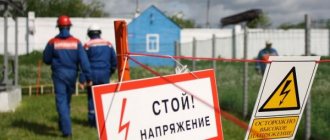- home
- > About the company
- > Articles
- > Installation of electrical installations with voltage up to 1000 V
Electrical networks and installations are classified according to a number of criteria. But if we proceed from such an important point of installation and subsequent operation as electrical safety, then all installations can be conditionally divided into those with voltage:
- less than 1000V.
- exceeding 1000V.
This value is demarcating and is indicated in regulatory documents on electrical safety.
Which electrical personnel is assigned group 2 in electrical safety?
Electrical safety group 2 is assigned to electrical personnel who service electrical installations under the supervision of qualified specialists. Attention! Workers with the second electrical safety access group do not have the right to connect or disconnect electrical installations.
Interesting materials:
Why do we need safety precautions in physical education? Why do you need Intel Rapid Storage Technology? Why is heavy water needed? Why is vertical synchronization needed in CS GO? Why should you wear underwear? Why are audit companies needed? Why are two cameras needed? What are side lights for? What is a microphone for? What are pegs used for on BMX?
Differences between networks with voltages up to and above 1000 volts
All AC electrical networks in the country are classified according to various parameters and primarily according to the voltage in them, namely networks up to 1000 volts and more than 1000 volts, in other words, low-voltage and high-voltage networks. Naturally, the higher the voltage in the electrical network, the more dangerous it is for those working with them and for humans in general.
The voltage limit in networks of exactly 1000 volts has developed historically and is currently strictly fixed in the Rules for the Construction of Electrical Installations (PUE). It is precisely this voltage differentiation that is indicated in the permits of electrical installation specialists, which give the right to work with electrical installations up to 1000 volts and over 1000 volts for others. The main fundamental difference in the design of both types of networks is that high-voltage networks are made with an insulated neutral, and low-voltage networks (up to 1000 volts) are made with a solidly grounded neutral.
That is, the neutral of a supply transformer with a voltage of up to 1000 volts has an electrical connection to the ground so that all electrical single-phase consumers under all conditions receive an electric current of one stable standard voltage, equal to 220 V in everyday life. If a short circuit to ground occurs in such networks, then the electric current in the network will instantly increase, as a result of which the overcurrent protection will operate. For the safety of using electrical appliances and electrical equipment designed for voltages up to 1000 volts, their housings must be grounded. In this case, if the device malfunctions, as a result of which its body may be energized, then when a person touches it, the electric current will rush to the ground without causing harm to the person.
The danger of human injury in everyday life from electric shock continues to remain quite high in our time. The main sources of danger are mainly the malfunction of the household electrical network, the malfunction of household electrical appliances, the lack of electrical protection devices and many other reasons.
High-voltage networks, as a rule, are quite long and with a symmetrical load, the neutral is isolated from the ground and in the event of a short circuit to the ground, the electric current increases slightly. A small increase in current in high-voltage networks, unfortunately, is not always detected by protection devices and does not always turn off the network, and therefore networks with voltages above 1000 volts are more dangerous for humans. It is precisely due to the increased danger of working with high-voltage electrical equipment that highly qualified specialists with the appropriate permit are allowed to work with it.
Working with high-voltage networks is also complicated because electric leaks occur quite often in them, as a result of which the degree of danger increases even more. For this reason, work with high-voltage networks and equipment is carried out in strict accordance with the requirements of the PUE and mandatory regulations.
Only compliance with all the requirements of the Rules for the Construction of Electrical Installations and the implementation of routine maintenance work on electrical networks within the established time limits, regardless of voltage and electrical equipment, is the main guarantee of electrical safety in everyday life and at work.
Single-pole voltage indicators
The single-pole indicator is housed in a single housing, also made of dielectric materials. All structural elements are located inside it. The main electrode is a tip fixed in the front part of the device, and the additional electrode is an electrode placed at the end or side of the body, ensuring contact with the specialist’s hand. Case sizes have a wide range, which allows you to choose the most convenient option.
The indicators are indicated at a voltage not exceeding 50 volts. It can be stepped and supplied with digital and other signals. Sound and light signals are given in intermittent or continuous form and must be clearly recognizable. The indication voltage for pulsed indicator signals is significant when the interval between pulses is no more than 1 second.
During the test, a single-pole indicator up to 1000V comes into contact with only one live part. Contact with the ground is provided from the side button through the finger of the hand, and then through the entire body to the pointer circuit. The current strength at this moment should not exceed 0.3 mA.
These devices are used only for testing equipment with alternating current, since with direct current the light bulb will not light up even when there is voltage in the circuit. With their help, secondary switching circuits are checked and phase wires in various devices are determined.
Electrical safety rules prohibit the use of a test lamp instead of a voltage indicator. A similar design consists of an incandescent lamp screwed into a socket connected to two short conductors. If such a lamp is accidentally turned on at a voltage higher than that for which it is designed, its bulb may explode.
What objects are possible for research?
"LABSIZ" carries out testing and measurement work for government orders and commercial structures for:
- management companies, HOAs, SNTs;
- preschool, general educational institutions: kindergartens, schools, colleges;
- technical schools, universities;
- clinics, laboratories, medical complexes;
- production, design enterprises;
- oil and gas storage facilities;
- gas stations;
- storage facilities;
- shopping, entertainment, business centers;
- restaurants, cafes, canteens;
- hotels, hotels, sanatoriums.
The contractor owns a mobile electrical laboratory up to 1000 V, which has all the necessary equipment on board. It provides field testing in remote, hard-to-reach areas.
Design and operation of bipolar indicators
The operating principle of these devices is based on comparing the potentials when it is connected to the live parts of the device being tested. At this moment, the resistance in the pointer resistors increases or decreases. A small current flowing in the terminals or wires affects the indicator, after which a light or sound signal begins to emit.
The lack of reaction of the indicator means, accordingly, the absence of voltage. If the indicator signal fades smoothly, this indicates the presence of residual energy in the wires.
As a rule, a two-pole indicator consists of two housings made of dielectric materials. Inside them there are elements that detect voltage and provide sound and light indication. To connect the housings, a flexible wire is used, the length of which is 1 meter or more.
At the inputs into the housing, the wire is equipped with shock-absorbing bushings or reinforced insulation. Each housing has an electrode tip, firmly fixed in a fixed place. Its uninsulated part should be no more than 7 mm, with the exception of indicators designed to work with overhead lines, for which this parameter depends on technical conditions.
Sometimes, in the presence of alternating current, capacitance may form in the metal parts of the indicator in relation to ground or other phases of electrical equipment. In this case, it is quite enough for the indicator light to start glowing when only one probe touches the phase. This phenomenon is eliminated by a shunt resistor, the resistance of which is the same as the additional resistor.
Research order:
- Specialists come to the site and inspect the facility. If necessary, an on-site laboratory is arranged.
- They check the technical documentation, get acquainted with reports on past tests (if they were carried out).
- Visually assess the condition of electrical installations, power cables, automatic shutdown devices, distribution lines. Identified deficiencies are immediately eliminated.
- Measure the insulation resistance of conductors, grounding, and protective devices.
- Based on the research results, a detailed technical report is drawn up. The document is suitable for submission to the customer and supervisory authorities. Prices for testing and measuring electrical equipment are determined according to the price list, depending on the volume and urgency of the work.
Where are electrical installations up to 1000 Volts used?
There are quite a large number of areas where solidly grounded electrical installations with a rated voltage not exceeding 1000 Volts are used. Basically, they are all divided into three main groups:
- stationary installations;
- mobile units;
- portable installations.
If mobile and portable electrical installations are the result of factory assembly and include everything necessary for work, then for the installation of stationary objects it is necessary to attract specialists from specialized companies.
The need to ground installations up to 1000
The main danger of installations up to 1000 Volts is the possibility of electric shock to a person who touches ungrounded equipment. As a result of such a touch to the ungrounded body of the electrical installation, current will pass through the person, which is dangerous to life and health. Only grounding will allow the current to go into the ground if a breakdown occurs in the electrical network up to 1000 Volts. Therefore, all work on the installation of electrical installations must be carried out in strict accordance with the norms and requirements of SNiP and PUE.
Differences between installations with voltages not exceeding 1000 V
Electrical installations and electrical networks, the voltage of which does not exceed 1000 Volts, have a solidly grounded neutral. In all other types of installations, an insulated neutral is required. That is, the transformer used with a voltage of less than 1000 Volts is grounded by an electrical connection. As a result, single-phase consumers receive the same electrical power even with an asymmetric load. If the installation is purchased for domestic needs, then the standard value for it is 220 Volts.
On the other hand, a solidly grounded neutral will increase the current when a short circuit to ground occurs. As a result, a special automatic protection system is triggered. Accordingly, all equipment with this value must have maximum current protection.
How to carry out measurement and testing work
Commissioning tests of electrical equipment up to 1000 V are carried out when commissioning a new network or circuit, after reorganization, repair and restoration activities. "LABSIZ" performs a full cycle of assessing the state of the electrical network before starting active use.
Operational measurements are carried out at specified intervals during the operation of electrical equipment to ensure the safety of employees, machines, and industrial complexes. The period for repeating tests is from 3 months (at particularly hazardous facilities) to 3 years. It is possible to carry out an unscheduled assessment of the state of the electrical network - for example, after a power failure.
Electrical measurements up to 1000 V are trusted only to professional electricians. LABSIZ specialists are qualified and have approvals to work with electrical equipment and the measuring instruments necessary to obtain reliable results.






